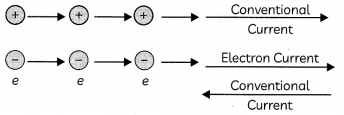Electric Current and Circuit
Electricity is a form of energy and can be readily transmitted over large distances with relatively small loss in energy. In this chapter we will discuss about electric circuits, potential difference and flow of current in an electric circuit. We will also discuss Ohm’s law and the heating effect of electric current and its applications.
A continuous and closed path of an electric current is called an electric circuit.
Electric Current
Electric current is expressed by the amount of charge flowing through a particular of area in unit time. It is defined as the rate of flow electric charges i.e., the charge flowing per unit time.
Let Q denote the amount of charge flowing across a given point in the conductor in time t, then the current flowing is given by, I = Q/t.
Conventional Direction of Current flow
It is the direction in which the positive charges flow which is opposite to the direction of the flow of negative charges.

Ampere: One Ampere is defined as the current flowing when 1 Coulomb of charge flows across a point in 1 second.
1 Ampere = \(\frac{1 \text { Coulomb }}{1 \text { second }}\)
Small quantities of current are expressed in milliampere (1 mA = 10-3 A) or in microampere (1 yA = 10-6A).
Coulomb: It is the SI unit of charge and is the charge carried by 6 × 1018 electrons, since the charge of 1 electron = 1.6 × 10-19 C.
Example 1.
Calculate the number of electrons constituting one coulomb of charge.
Answer:
The charge on one electron (e) = 1.6 × 10-19 C.
Also, Charge q = ne, where n is the number of electrons. Therefore,
n = \(\frac{q}{e}=\frac{1}{1.6 \times 10^{-19}}\) = 6.25 × 1018 electrons
e 1.6 × 10-19
Ammeter: It is an instrument to measure electric current in a circuit and is always connected in series in a circuit through which the current is to be measured. The electric current flows in the circuit shown from the positive terminal to the negative terminal of the cell through the bulb and the ammeter.

Figure above shows the schematic diagram of a typical electric circuit comprising a celL, an electric bulb, an ammeter and a plug key. The electric current flows in the circuit from the positive terminal of the cell to the negative terminal of the cell through the bulb and ammeter.
The flow of charge inside a conductor: When a wire is connected to a battery, the electrons which were drifting randomly in all directions, now become aligned in a particular direction and current begins to flow across the wire. When a steady current flows through a conductor, the electrons in it move with a certain average drift velocity.